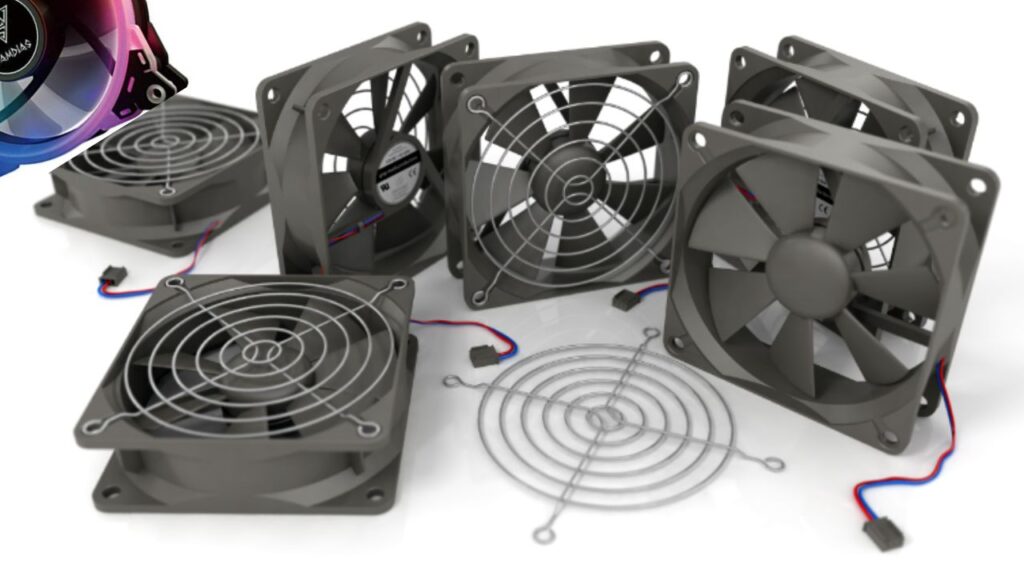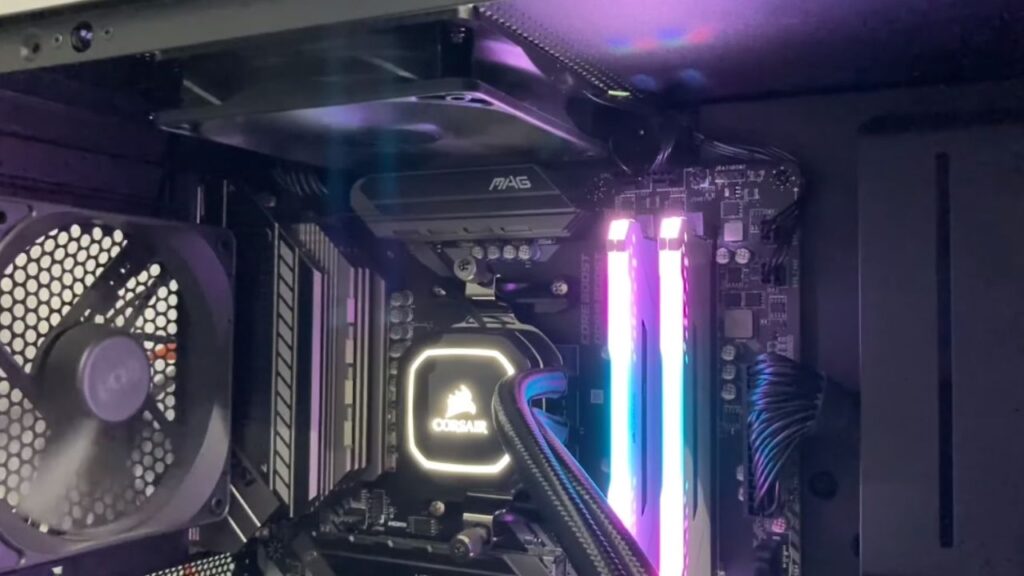When building or upgrading a computer, understanding the various components and their functionalities is crucial.
Two essential elements that play a pivotal role in maintaining optimal performance and temperature regulation are the CPU fan header and the system fan header.
In this article, we’ll delve into the key differences between these two components and explore their distinct roles in a computer system.
What is a CPU fan header?
A CPU fan header is a 4-pin connector on a computer motherboard that provides power and control signals to a CPU fan. The CPU fan is responsible for cooling the central processing unit (CPU), which is the brain of the computer. The motherboard monitors the CPU temperature and adjusts the fan speed accordingly to keep the CPU from overheating.
The CPU fan header is typically located near the CPU socket on the motherboard. It is labeled “CPU FAN” or “CPU_FAN“. The header has four pins:
Pin 1: Ground
Pin 2: +12V DC power
Pin 3: Fan speed sensor
Pin 4: PWM fan control
To connect a CPU fan to the header, plug the PC fan connector into the header. The fan connector is keyed, so it can only be plugged in one way. Once the fan is connected, the motherboard will automatically detect it and start controlling its speed.
Some motherboards also have a second CPU fan header labeled “CPU OPT” or “CPU_OPT.” This header is typically used for a secondary CPU fan, such as the one on a high-end CPU cooler. The CPU OPT header works the same way as the CPU FAN header.
If you need help determining which header to connect your CPU fan to, consult your motherboard manual.
What is a system fan header?
A system fan header is a connector on a computer motherboard that is specifically designed for connecting and controlling system fans. System fans are used to cool various components inside the computer case, such as the CPU, GPU, and hard drives.
System fan headers are typically located near the edges of the motherboard. They are labeled “SYS_FAN” or “SYSFAN“. Each header has four pins:
Pin 1: Ground
Pin 2: +12V DC power
Pin 3: Fan speed sensor
Pin 4: PWM fan control
To connect a system fan to the header, plug the PC fan connector into the header. The fan connector is keyed, so it can only be plugged in one way. Once the fan is connected, the motherboard will automatically detect it and start controlling its speed.
The motherboard can control the speed of system fans in two ways:
Voltage control: The motherboard can adjust the voltage supplied to the fan, which will change its speed.
PWM control: The motherboard can send a PWM signal to the fan, which will control its speed more precisely.
Most modern motherboards use PWM control for system fans. This is because PWM control is more efficient and allows for finer control over fan speed.
Some motherboards have multiple system fan headers. This allows you to connect multiple system fans to the motherboard and control them independently.
If you need help determining which header to connect your system fan to, consult your motherboard manual.
Differences Between CPU Fan Header Vs. System Fan Header
Location and Purpose:
CPU Fan Header: The CPU fan header is a specific connector on the motherboard designed to power and control the CPU cooling fan. Its primary purpose is to ensure that the CPU stays within a safe temperature range during operation. The CPU fan is crucial for preventing overheating, as excessive temperatures can lead to performance issues and even permanent damage to the processor.
System Fan Header: On the other hand, the system fan header is a more general-purpose connector that is used to power and control additional fans within the computer case. System fans contribute to overall airflow, helping to cool other components such as the GPU, RAM, and storage devices. These fans are vital for maintaining a balanced temperature throughout the entire system.
Control and Regulation:
CPU Fan Header: The CPU fan header often features more advanced control options and monitoring capabilities. Motherboards typically include BIOS/UEFI settings that allow users to adjust the fan speed based on the CPU temperature. This dynamic control ensures that the fan operates more efficiently, ramping up its speed when the CPU is under heavy load and slowing down during idle periods.
System Fan Header: System fan headers may also offer some level of control, but they are generally less sophisticated than CPU fan headers. Users may be able to adjust the speed manually or set predefined profiles, but the precision of control might not be as granular as with the CPU fan header.
Number of Headers:
CPU Fan Header: A motherboard typically has one dedicated CPU fan header. This is because there is only one primary cooling solution for the CPU, and having multiple headers for the CPU fan would be redundant.
System Fan Header: Motherboards often come equipped with multiple system fan headers, accommodating the need for additional cooling within the case. The number of system fan headers varies depending on the motherboard model and its intended use, ranging from two to several headers.
Compatibility and Considerations:
CPU Fan Header: The CPU fan header is specifically designed for the CPU cooler. Users must ensure that the CPU fan is connected to this header to guarantee proper cooling and temperature regulation for the processor.
System Fan Header: System fan headers are versatile and can be used for various cooling purposes. Users can connect case fans, GPU coolers, or other cooling solutions to these headers. It’s essential to consider the power requirements and compatibility of the fans with the system fan headers.
Types of Computer Fans
Computer fans come in various types, each designed for specific purposes within a computer system.

Here are some common types of computer fans:
CPU Fans: As discussed earlier, CPU fans are specifically designed to cool the central processing unit (CPU). They are typically mounted on or near the CPU heatsink to dissipate heat generated by the processor.
Case Fans: Case fans, also known as system fans, are used to maintain airflow within the computer case. They help cool other components such as the GPU, RAM, and storage devices. Case fans come in different sizes (typically 80mm, 120mm, and 140mm) and are mounted on the case itself.
GPU Fans: Graphics processing units (GPUs) in dedicated graphics cards also have fans to dissipate heat generated during intensive graphical tasks. In some high-performance GPUs, multiple fans or advanced cooling solutions may be employed.
Power Supply Fans: Power supplies have built-in fans to cool the internal components of the power supply unit (PSU). The fan’s size and speed vary based on the power supply’s design and capacity.
Northbridge/Southbridge Fans: Older motherboards with separate Northbridge and Southbridge chipsets sometimes featured small fans to cool these chipsets.
VRM (Voltage Regulator Module) Fans: Some high-end motherboards may have fans dedicated to cooling the VRM, which regulates the voltage supplied to the CPU. These fans help maintain stable power delivery to the CPU during demanding tasks.
Memory Fans: While less common, some enthusiasts may use specialized fans or cooling solutions to cool the memory modules (RAM) on their motherboards.
Hard Drive Cooling Fans: In some cases, additional fans may be mounted near hard drives or storage bays to help maintain lower temperatures for storage devices.
Liquid Cooling Fans: Liquid cooling systems use fans to dissipate heat from the radiator. These fans are part of a larger cooling solution that includes tubes, a pump, and a heat exchanger.
Intake vs. Exhaust Fans: Fans in a computer case can be categorized as intake or exhaust fans. Intake fans draw cool air into the case, while exhaust fans expel hot air.
PWM Fans: PWM (Pulse Width Modulation) fans support dynamic speed control. They can adjust their speed based on the PWM signal received, allowing for more precise and efficient cooling.
Conclusion:
In summary, while both the CPU fan header and the system fan header contribute to the overall cooling of a computer system, they serve distinct purposes.
The CPU fan header is tailored for the CPU cooler, offering advanced control and monitoring.
In contrast, the system fan header provides a more general solution for cooling other components within the case.
Understanding these differences is crucial for optimal system performance and temperature management in any PC build.
FAQ:
What is a fan splitter?
The PWM fan splitter is a device that allows the connection of two computer fans to a single motherboard fan header. This facilitates the installation of additional fans, enhancing the cooling capabilities of the PC.
What type of connector do PC fans use?
The majority of cooling fans are designed to interface with a computer through a standard connector. In contemporary setups, the prevailing practice involves employing either 4-pin or 3-pin specialized fan headers.
Additionally, standard MOLEX 4-pin peripheral connectors are commonly utilized. Arranged from left to right in the visual spectrum are the following connectors: a 3-pin connector, a 4-pin connector, and a MOLEX connector.
Read More – >>> 120mm vs 140mm Fans

